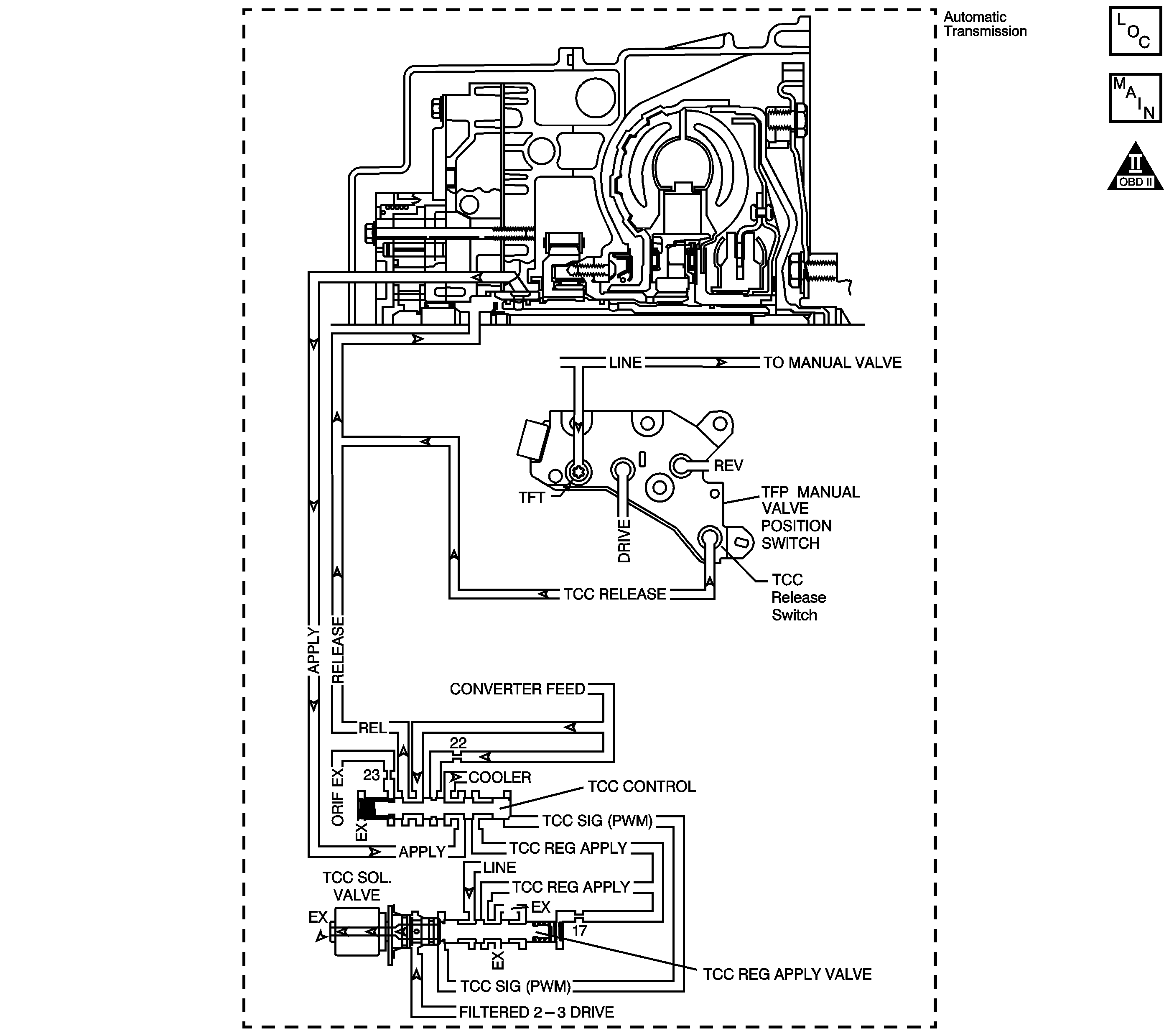
Circuit Description
The torque converter clutch (TCC) solenoid valve is a pulse width modulation (PWM) solenoid. When vehicle operating conditions are appropriate for TCC application, the transmission control module (TCM) begins the TCC duty cycle at approximately 42 percent. The TCM then increases the duty cycle up to 90 percent, in order to achieve full TCC-apply pressure.
When the TCC PWM solenoid valve is de-energized, the solenoid blocks filtered 2-3 drive fluid, and allows TCC signal fluid to exhaust. When energized, the solenoid modulates fluid into the TCC signal fluid circuit. When fully energized, modulation stops, and the solenoid blocks both 2-3 drive fluid and TCC signal fluid exhaust.
The TCC release switch is part of the automatic transmission fluid pressure (TFP) manual valve position switch. The TFP manual valve position switch is attached to the control valve body.
The TCC release switch is a normally-closed switch. The switch signals the TCM that the TCC is released. Torque converter release fluid pressure acts on the switch contact, opening the signal circuit. When the voltage on the circuit is high, the TCM recognizes that the TCC is no longer engaged.
When the TCM detects that the TCC release switch is closed when the TCC is commanded OFF, then DTC P0742 sets. DTC P0742 is a type B DTC.
DTC Descriptor
This diagnostic procedure supports the following DTC:
DTC P0742 Torque Converter Clutch (TCC) System - Stuck On
Conditions for Running the DTC
| • | No MAP DTCs P0107 or P0108. |
| • | No TP DTCs P0120 or P0220. |
| • | No ISS DTCs P0716 or P0717. |
| • | No OSS DTCs P0722 or P0723. |
| • | No TCC Stuck OFF DTC P0741. |
| • | The engine is running for 5 seconds. |
| • | The transmission fluid temperature (TFT) is 20-130°C (68-266°F). |
| • | The Calc. Throttle Position is between 8-90 percent. |
| • | The engine torque is greater than 50 N·m (37 lb ft). |
| • | The vehicle speed is 16 km/h (10 mph) or more. |
| • | The TCC is commanded OFF. |
| • | The gear ratio is between 1.739:1 and 0.633:1. |
Conditions for Setting the DTC
The TCM detects the TCC slip speed is -20 RPM to +40 RPM when the TCC is commanded OFF for 6 seconds, 3 times during the same trip.
Action Taken When the DTC Sets
| • | The TCM requests the ECM to illuminate the malfunction indicator lamp (MIL) during the second consecutive trip in which the Conditions for Setting the DTC are met. |
| • | The TCM commands maximum line pressure. |
| • | The TCM commands TCC engagement. |
| • | The TCM freezes transmission adaptive functions. |
| • | The ECM records the operating conditions when the Conditions for Setting the DTC are met. The ECM stores this information as Freeze Frame and Failure Records. |
| • | The TCM records the operating conditions when the Conditions for Setting the DTC are met. The TCM stores this information as Failure Records. |
| • | The TCM stores DTC P0742 in TCM history during the second consecutive trip in which the Conditions for Setting the DTC are met. |
Conditions for Clearing the MIL/DTC
| • | The TCM turns OFF the MIL during the third consecutive trip in which the diagnostic test runs and passes. |
| • | A scan tool can clear the MIL/DTC. |
| • | The TCM clears the DTC from TCM history if the vehicle completes 40 warm-up cycles without an emission related diagnostic fault occurring. |
| • | The TCM cancels the DTC default actions when the ignition switch is OFF long enough in order to power down the TCM. |
Diagnostic Aids
| • | DTC P0742 could be falsely set due to default actions from another DTC set. If DTC P0842, U0073, or U0100 are also set, diagnose those DTCs first. |
| • | Rapid fluctuation in line pressure could set DTC P0742. |
| • | Inspect for a pressure regulator condition. |
| • | Inspect for abnormal high or low line pressure. |
| • | The customer may notice an engine stalling condition. |
Test Description
The numbers below refer to the step numbers on the diagnostic table.
-
This step ensures that the TCC release switch is in good working condition.
-
This step tests the TCC circuit for a mechanical or hydraulic condition.
Step | Action | Yes | No | ||||||||||||||
|---|---|---|---|---|---|---|---|---|---|---|---|---|---|---|---|---|---|
1 | Did you perform the Diagnostic System Check - Vehicle? | Go to Step 2 | |||||||||||||||
2 |
Important: Before clearing the DTC, use the scan tool in order to record the Freeze Frame and Failure Records. Using the Clear Info function erases the Freeze Frame and Failure Records from the TCM. Does the scan tool indicate TCC release pressure is present? | Go to Diagnostic Aids | Go to Step 3 | ||||||||||||||
Did you find and correct a condition? | Go to Step 6 | Go to Step 4 | |||||||||||||||
Refer to Control Valve Body Disassemble . Did you find and correct a condition? | Go to Step 6 | Go to Step 5 | |||||||||||||||
5 | Replace the TCM. Refer to Control Module References for replacement, setup, and programming. Did you complete the replacement? | Go to Step 6 | -- | ||||||||||||||
6 | Perform the following procedure in order to verify the repair:
Has the test run and passed? | Go to Step 7 | Go to Step 2 | ||||||||||||||
7 | With the scan tool, observe the stored information, capture info and DTC info. Does the scan tool display any DTCs that you have not diagnosed? | System OK |
